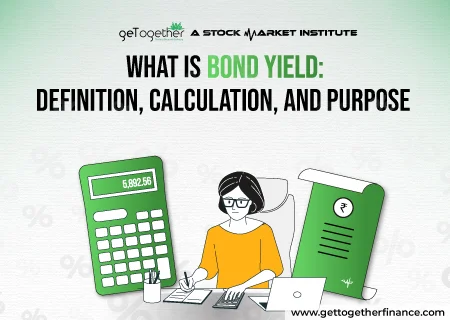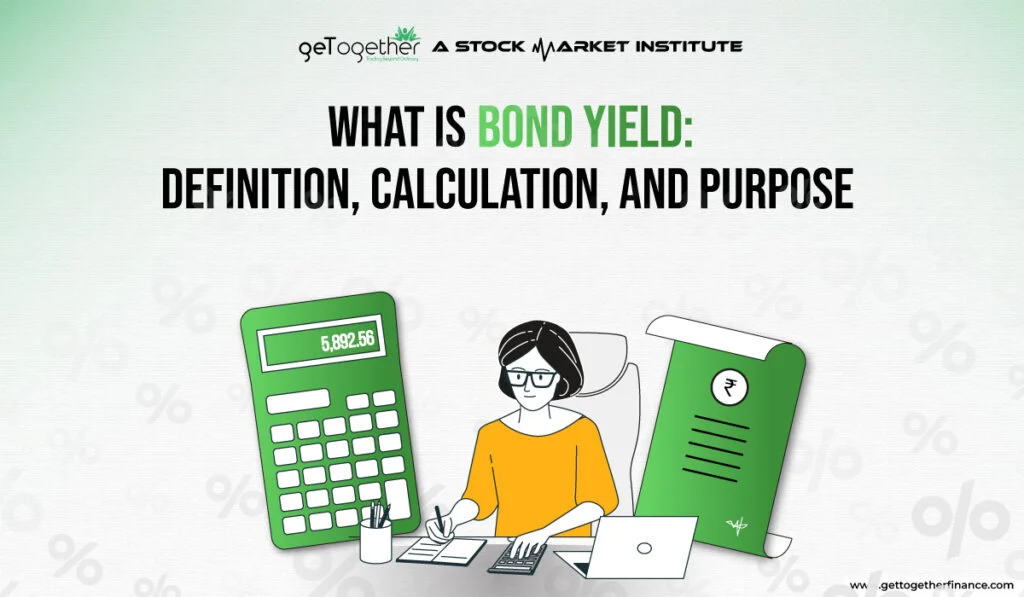What is Bond Yield: Definition, Calculation, and Purpose
- May 3, 2024
- 3028 Views
- by Arun Singh Tanwar


You would quickly answer “Return on Investment” if asked about your investment criteria. We make investments so that we can earn regular income or create wealth. Put simply, bond yield is the return you can expect yearly by purchasing a bond.
In this blog, you will learn all about bond yield in India, its types, calculations, and much more. You will also learn how you can decide to invest in bonds.
Table of Contents
ToggleWhat Is a Bond Yield?

Bonds are long-term debt instruments that provide a fixed return in the form of Coupon interest. In simple terms, this is the bond yield. But, this doesn’t consider many variables that help calculate the bond’s effective yield.
When assessing the bond yield today for future coupon payments, it is important to factor in the time value of money, frequency of interest payout, market price, etc.
Here are the types of bond yield and their brief explanation:
- Coupon Yield: The annual interest rate paid to the bondholder is called coupon yield. This amount is fixed throughout the lifetime of the bond. Coupon yield is calculated on the face value of the bond.
- Current Yield: When the annual interest, i.e., coupon rate, is calculated as a percentage of the Current Market Price of the bond, it is called current yield.
- Bond Equivalent Yield (BEY): Unlike coupon or current yield that assumes interest payouts to be annual, BEY calculates the annualized bond yield for monthly, quarterly, or half-yearly interest payouts. You can earn more by reinvesting this money leading to compounding income.
- Yield to Maturity (YTM): Under YTM, the returns are calculated by identifying the rate of return or discount rate at which the Present Value of all the coupon payments is equal to the face value of the bond. This rate is alternatively called the Internal Rate of Return (IRR) and is calculated using the trial-and-error method.
- Yield to Call (YTC): This method is applicable for callable bonds that the issuing company can call before the maturity date. Usually, the call price is at a premium to the face value of the bond. The method of calculation is the same as YTM.
Formula and Calculation of a Bond Yield

Having learned about the types of bond yields, you need to understand their calculations. Here are the calculations for all these types of yield, with an example.
Ex: Company X issues a bond with a maturity of 5 years with a face value of Rs. 1,000 and coupon payment of 10% p.a. The Current Market Price of the Bond is Rs. 900. The bond will be redeemed at Rs. 1,100 after 5 years.
- Coupon Yield
| Formula | Coupon Yield = Interest PaidFace Value of the Bond100 |
Interest Payment = 10% of 1000 = Rs. 100
| Calculation | Coupon Yield = 1001000100 = 10% |
- Current Yield
| Formula | Current Yield = Interest PaidCurrent Market Price of the Bond100 |
Interest Payment = 10% of 1000 = Rs. 100
| Calculation | Coupon Yield = 100900100 = 11.11% |
- Bond Equivalent Yield
Formula | Bond Equivalent Yield (BEY) = 1+Interest RateN100NN = Frequency of interest payments in a year |
Suppose the interest payout in the above example is twice yearly, i.e., N = 2. Then, the BEY will be calculated as follows:
Calculation | Bond Equivalent Yield (BEY) = 1+1021002= 1.1025 or 10.25% p.a. |
- Yield to Maturity (YTM)
Formula | Face Value=Present ValuePresent Value=Interest Paid1+YTM100t+Face Value1+YTM100tt = Year |
As YTM is not known, we have to use the trial & error method to equate face value with the present value.
Calculation | 1000=1001+YTM1001+…+1001+YTM1005+11001+YTM1005YTM = 11.59% p.a. To verify your trial & error result, you can substitute the YTM value in the above equation and check whether LHS = RHS. |
Understanding Bond Yields
Bonds are debt instruments used to borrow money. The only difference is that companies can issue bonds in dematerialized form to the masses. Unlike traditional debts given by banks and financial institutions, bonds provide investment opportunities for people who want secured and steady returns.
Now that you know what is yield in bonds, it’s time to look at the characteristics and features of different types of bonds.
Also Read: Floating Rate Bonds
Characteristics of bonds

- Face Value: Face value is the base price of a bond decided by the issuer.
- Issue Price: The price at which a bond is issued to the investors. It can be lower or higher than the face value of the bond.
- Coupon Rate: The bond rate of interest paid to the investors. The coupon rate is always calculated on the face value of the bond.
- Tenure: The number of years a bond remains floated in the market before maturity is the tenure of a bond. The tenure affects the coupon rates of the bond.
- Market Price: The price at which a bond is available to be traded in the market. It is inversely proportional to the interest rate changes in the market. The market price can be higher or lower than the face value.
- Maturity Value: The value at which a bond is redeemed. The maturity can either be at face value or include a premium.
Credit Quality: Along with bond yield, you should also look at the quality ratings of a bond before investing. In India, agencies like CRISIL & ICRA provide credit ratings to bonds. Safer bonds on the parameters of liquidity, financial stability & good prospects are provided a rating of AAA to BBB+.
Types of bonds

Here are some popular types of bonds:-
- Fixed Rate Bonds: The bonds that provide a fixed coupon rate throughout the bond’s tenure.
- Flexible Rate Bonds: The bonds that update coupon rates in tandem with the change in interest rates.
- Zero-Coupon Bonds: ZCBs are bonds issued at a discount and redeemed at face value. The discount provided is the bond yield.
- Corporate Bonds: Bonds issued by companies to raise public debt to make capital expenditures. They usually provide a higher interest rate.
- Tax-Free Bonds: These bonds are issued by government companies like the NHAI to fund long-term projects. Their maturity is usually 10-15 years, and the interest earned on them is tax-free.
Tools & Calculators

You must have observed that, depending on the type of bond and other factors, calculating the fair price of the bond, as well as the bond yield, can be a complex task. Here you can take the assistance of online tools and calculators. With the help of such tools, you can identify the following:
- Calculate the fair value of the bond
- Calculate the accurate bond yield hassle-free
- Calculate and compare the present value of all the coupon payments
- Compare various bond yields in India and decide where to invest
Conclusion
There are many ways to calculate bond yield and analyze the benefits you get by investing in a bond. Understanding the return on investment of a bond will help you compare it with other investment options and make informed decisions.
FAQs
1. u003cstrongu003eWhat is bond yield, and why is it important?u003c/strongu003e
The return that investors get by investing in a bond is called the u003cstrongu003ebond yieldu003c/strongu003e. It provides a peek into the strength and safety of a bond as well as the prospects of returns.
2. u003cstrongu003eHow is bond yield defined in financial terms?u003c/strongu003e
The percentage return on the face value or the market price that a bondholder earns is calledu003cstrongu003e bond yieldu003c/strongu003e.
3. u003cstrongu003eCan you explain the basic calculation of bond yield?u003c/strongu003e
The coupon yield indicates the basic interest income on a bond for the investors. The formula for coupon yield is:u003cbru003eu003cbru003eCoupon Yield = Interest Paid/Face Value*100u003cbru003eInterest paid = Coupon Rate x Face Value of the Bond
4. u003cstrongu003eWhat factors influence the bond yield of a security?u003c/strongu003e
u003cstrongu003eEconomic Growth: u003c/strongu003eAs economic growth rises, investors can expect higher u003cstrongu003ebond yieldsu003c/strongu003e because the income of the companies issuing the bonds also increases.u003cbru003eu003cstrongu003eTenure: u003c/strongu003eDue to the time value of money, the u003cstrongu003ebond yieldu003c/strongu003e can be different for short-term and long-term bonds.u003cbru003eu003cstrongu003eInflation: u003c/strongu003eRising inflation leads to an increase in interest rates and a decrease in the present value of future cash flows.u003cbru003eu003cstrongu003eInterest Rates: u003c/strongu003eIn reaction to inflation, the interest rates in the market go up or down. The interest rate and u003cstrongu003ebond yieldu003c/strongu003e are inversely proportional.u003cbru003eu003cstrongu003eCredit Risk: u003c/strongu003eRisky bonds offer more interest to lure investors. Whereas, safer bonds don’t need such tactics and provide stable returns.
5. u003cstrongu003eAre there different types of bond yields?u003c/strongu003e
Yes. There are various types of u003cstrongu003ebond yieldsu003c/strongu003e:u003cbru003eCoupon yieldu003cbru003eCurrent Yieldu003cbru003eBond Equivalent Yield (BEY)u003cbru003eYield to Maturity (YTM)u003cbru003eYield to Call (YTC)
6. u003cstrongu003eHow does the coupon rate affect bond yield?u003c/strongu003e
u003cstrongu003eBond yieldu003c/strongu003e is directly proportional to the coupon or interest payments. Hence, higher coupon rates lead to higher bond yields and vice-versa.
7. u003cstrongu003eWhat is the relationship between bond prices and yield?u003c/strongu003e
Bond prices and yield are inversely proportional in comparison to other bonds. Suppose Bond B provides more yield than Bond A. It will cause a rise in the prices of Bond B and a fall in the prices of Bond A.
8. u003cstrongu003eWhy do investors consider bond yield when investing?u003c/strongu003e
Bond yield is the reflection of many factors that make a bond an attractive investment. By comparing different u003cstrongu003ebond yields in Indiau003c/strongu003e, you can easily identify the best investment opportunities.
9. u003cstrongu003eCan bond yield be negative, and if so, what does it mean?u003c/strongu003e
The u003cstrongu003ebond yieldu003c/strongu003e generally is always positive unless the following scenario plays out.u003cbru003eu003cbru003eFace Valueu003ePresent Value of (Coupon Payments+Mautrity Value)
10. u003cstrongu003eHow does the maturity of a bond impact its yield?u003c/strongu003e
If you hold the bond until maturity, the best u003cstrongu003ebond yieldu003c/strongu003e is YTM. It accounts for the total return on a bond until maturity.



